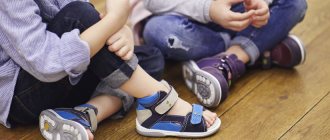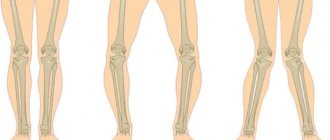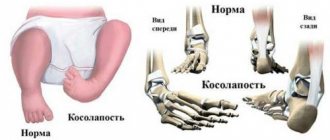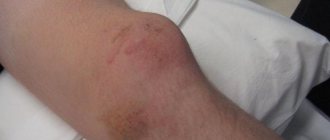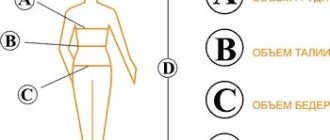It is not possible to accurately determine foot size based on the child’s age. Children have different builds, so there is no specific standard. Different countries approach the determination of the parameters under consideration from different points of view, which also complicates the task. Finally, in Russia the units of measurement are centimeters, and in the USA they are inches, so the markings are very different from each other. Today we will tell you in detail how to determine the size of a child’s feet without focusing on age.
How to correctly determine
Some mothers prefer to choose new clothes for their baby on their own, without his presence.
Trying to buy children's shoes at random is often doomed to failure. Buying booties for children under one year of age does not cause much trouble for parents. The time children under one year old wear shoes is limited to walking in a stroller; there is no additional load on the legs. The length of a newborn's foot can be measured with a tape measure in any position. For the smallest boys and girls, manufacturers indicate boot sizes in months:
- 0 – 3 months. The foot of a newborn is no more than 9.5 cm.
- 3 – 6 months. Foot length is about 10 – 10.5 cm.
- 6 – 12 months. A child's leg grows to 11 - 12 cm.
The baby is not interested in what the booties look like; the design and color are chosen by the mother to suit her taste. Shoes for the baby’s first steps must be new; a worn pair has been “adapted” to the characteristics of the previous owner’s feet.
There is a simple method for determining the foot size of children over one year old. By following the recommendations outlined in it, you can determine the size with high accuracy.
- Place thick sheets of paper under both of the child’s legs and trace them with a pencil. The baby should stand; in this position, the load on the legs is maximum, and the area of the foot increases. If you can’t stand, you can circle the prints of wet feet.
- Measure the length of each foot from the most prominent point of the heel to the outermost point of the big toe. Add the measurements and divide by two. Using a simple calculation, you can get the arithmetic mean of the length of the foot. This point is very important; physiologically, one leg may be larger than the other. When purchasing, you should focus on a longer length.
- Add 0.5 cm to the resulting number if you plan to purchase sandals; add 1.5 cm if you are buying boots for autumn and winter. The stock is intended for a warm sock and to retain heat inside the boots.
In the store, the finished mark must be applied to the inner insole of the pair you like. You can also use the insole from old children's shoes, purchasing new ones taking into account a margin of 1.5 - 2 cm.
It is necessary to take into account the individual physiological data of the leg: fullness and elevation.
Shoe size: table for children by age in Russia
| Age | Size |
| From 3 months up to six months | 16; 16,5, 17 |
| From six months to 9 months. | 18; 19 |
| From 9 months up to a year | 19,5; 20 |
| From a year to a year and a half | 20-22 |
| From one and a half to 2 years | 22-23 |
| From 2 to 3 years | 23-25 |
| From 3 to 4 years | 25-26 |
| From 4 to 5 years | 26-28 |
| From 5 to 6 years | 28-30 |
| From 6 to 7 years | 30-31 |
| From 7 to 8 years | 31-32 |
| From 8 to 10 years | 33-35 |
For boys
Boys have a different physical development than girls; their feet grow faster. Therefore, the size table looks like this:
| Boy, age | Size |
| From 3 months to six months | 16; 16,5; 17 |
| From six months to 9 months. | 18; 19 |
| From 9 months up to a year | 19,5; 20 |
| From 12 months up to 18 months | 21; 22 |
| From 2 to 3 years | 22,5 |
| From 4 to 5 years | 25,5; 26 |
| From 5 to 6 years | 28; 28,5 |
| From 6 to 8 years | 30; 31 |
| From 8 to 12 years | 33; 34; 35; 36 |
- Healthy candies: recipes
- Can a child have chocolate?
For girls
The size chart for girls looks like this:
| Girl, age | Size |
| From 3 months to six months | 16; 16,5; 17 |
| From six months to 9 months. | 18; 19 |
| From 9 months up to a year | 19,5; 20 |
| From 12 months up to 18 months | 21; 22 |
| From 18 months up to 2 years | 23; 24 |
| From 2 to 3 years | 25 |
| From 3 to 4 years | 27 |
| From 4 to 5 years | 28; 28,5 |
| From 5 to 6 years | 29 |
| From 6 to 7 years | 31,5; 32 |
How does a child's foot length change by month?
A newborn’s foot goes through several stages of formation as it grows, so it is advisable for parents to closely monitor changes in the baby’s foot
It is extremely important to know what a limb looks like at a given age in order to prevent pathological changes. The size of children's feet by age is ambiguous - it is constantly changing
This is especially true for one-year-old toddlers, who need high-quality and suitable shoes no less than adults.
If you don't take care of your baby's feet right away, it can result in a number of serious orthopedic problems when he gets older. For the first few years, babies' feet consist of cartilage, which over the years turns into bone tissue. Modern shoes are made taking into account the smallest anatomical features of a child’s foot, which allows the foot to form correctly. To prevent problems, parents need to not only know exactly what size the child’s feet are by age and buy high-quality wardrobe items, but also visit an orthopedist after the child is five years old.
A baby's foot may grow unevenly, so it is recommended to monitor the size of the child's foot by age. From birth to one year and from one to three years, the value should be measured no more often than once every three months. During this time, the parameters of the foot change. At the age of three to six years, it is necessary to take measurements a little less often - once every four months. As for boys and girls from six to ten years old, their feet should be measured once every five months. This tip will help you monitor your child's foot growth and choose appropriate shoes.
The length of a child’s leg by age is determined as follows:
- It is best to measure the feet of infants with a tape measure or a string, which is then attached to a ruler. This is the easiest way to find out the foot size of newborns by month.
- For older children, the length of the foot is determined in a standing position. The legs should be placed on the paper, then traced around the edge with a pencil. You can wet your feet in water so that a wet mark remains on the sheet. Then you need to measure the length of both prints, add the data and divide in half. As a result, you will receive a figure for accurately determining the size of the feet of children by age, because the feet may not be the same in length. You should focus on the parameters of the larger foot.
- Remember that in summer you should add half a centimeter to the size, taking into account that the leg may swell. In winter, add one and a half, because a warm sock must fit into the shoes and there is still space for air circulation.
Baby's foot size by month
Each baby is individual, but in pediatrics there are generally established standards. They help parents monitor the growth and development of the baby. Foot size is no exception. Using the table below, you can easily find out the average foot length of your baby from birth to age five. To calculate your child’s foot size by month, use the following calculations:
| Age | Foot length | |
| centimeters | inches | |
| 0-3 months | 9,5 | 3,7 |
| 3-6 months | 10,5 | 4,1 |
| 6-12 months | 11,7 | 4,6 |
| 12-18 months | 12,5 | 4,9 |
| 18-24 months | 13,4 | 5,2 |
| 2 years | 14,3 | 5,6 |
| 2.5 years | 14,7 | 5,8 |
| 2.5-3 years | 15,2 | 6 |
| 3-3.5 years | 16 | 6,3 |
| 4 years | 17,3 | 6,7 |
| 4-4.5 years | 17,6 | 6,9 |
| 5 years | 18,4 | 7,2 |
Sizing systems in different countries
The following dimensional systems are available today:
- The metric system used in Russia is compiled according to the International Standard ISO 3355-77. Here the size corresponds to the length of the foot in millimeters. For convenience, all indicators are rounded to 0.5 cm. The distance from the protruding (usually thumb) toe to the heel will be an indicative value. There are no additional amendments regarding the shape of the block, so this system is the simplest and most understandable. The size interval in Russian shoes is 0.5 cm.
- The stichmass (European) system is used for imported shoes. The unit of measurement for the length of the insole (and size, respectively) is taken to be 6.7 mm. It is taken into account that the insole, as a rule, is longer than the foot by about 15 mm. This is due to the fact that there is a margin for allowance in the length of the insole. This nuance is the reason for incorrect conversions of sizes from one system to another.
- English shoes are measured in inches, where an inch is equal to 2.54 centimeters. For booties for newborn babies, size 0 is intended (we recommend reading: how to knit booties with two knitting needles for newborns?). Measurement is taken 4 inches from the heel. Spacing between dimensions is 1/3 inch.
- The Chinese measurement system follows the Russian one and takes as a basis the distance from toe to heel.
- The system in the USA, Canada and Australia is also measured in inches. The shift goes towards zero by 1/12 (2.1 mm).
READ ALSO: how to crochet booties for a newborn?
Based on the standard size system, so popular today, you can set the following size of a child’s feet by month: from 6 to 9 months - number 17, from 9 to 12 months - number 18, for a one-year-old child - number 19-21.
READ ALSO: clothing sizes for newborns: tables of child growth by month up to 1 year It often happens that a girl’s leg at this age has a lower figure (18 or even less). When choosing winter shoes, sizes from 20 to 23 are considered. You can select the exact size of a child’s feet using the tables.
Useful tips
Children grow quickly, so you need to buy shoes with a reserve. To determine it, you should add from 0.5 to 1.5 cm to the size of children's shoes indicated in centimeters, depending on the season. The result will be the length of the foot, and products selected according to this parameter will be just right for growth.
In order not to make a mistake with the size, up to a year you should take measurements by month. Up to 2 years of age, you need to measure your baby’s feet every 2 months. The older the child gets, the slower his parameters change. Between the ages of 3 and 6, measurements should be taken four times a year; after 7, two times will be sufficient. Due to the asymmetry of the body, one foot is always longer than the other, so a larger value is taken as a basis.
Another significant point is the rise. This is the distance from the floor to the ankle joint. Shoes with a low instep are not suitable for those with high feet. Most often it just won't fit. Even if you managed to squeeze your leg in, it would be impossible to walk. Unfortunately, this parameter is not specified by manufacturers. It has to be determined by eye or by trying on products.
If you can hold the shoes in your hands, you can also measure the instep. On shoes and boots, this is the distance from the floor to the fastener. On boots - from the floor to the transition to the boot
By paying attention to this point, you can avoid returns and exchanges.
When purchasing children's shoes without trying them on, you should carefully study all the characteristics in the description, look at the model in photographs, and, if available, in the video. You also need to read about the manufacturer, go to its official page (children's sizes are often published there), and read the reviews. If you have not yet had experience purchasing shoes in a particular store, then for the first time it is better to choose models with Velcro, lacing, elastic inserts, and also a size larger than required. It's better to have an extra pair for growth.
You need to buy shoes with a reserve
Up to 2 years of age, you need to measure your baby’s feet every 2 months.
When choosing, take into account the rise of the product
Explore characteristics and reviews
The nuances of choosing high-quality and comfortable children's shoes
As we have already said, a child’s growing feet must be in the right shoes to avoid health problems. Not only the table is important, but also the following points when purchasing:
- the chosen pair should not be heavy. Heavy and “wooden” shoes are a sign of low quality and will most likely be extremely uncomfortable to wear;
- the presence of an instep support (thickening on the insole under the middle part of the foot), which protects against the development of flat feet;
- pay attention to the toe – we recommend choosing round and not tapered ones, as they will not put pressure on the sides of the toes;
- The sole is very important, especially for demi-season shoes. It should bend well and not slip, in addition, we recommend choosing one that protrudes slightly in front of the toe - it will protect the toe from stones, curbs, and so on;
- the material is no less important, summer shoes and sandals made of genuine leather will not allow your feet to sweat, and winter boots or boots made of membrane rubber or special fabric with a fleece inside will not get wet and will always keep you warm;
- fasteners, laces and Velcro. Decide for yourself whether your baby can cope with constantly tying his shoelaces or whether it is better to take something with Velcro;
- appearance. Seams, adhesive connections, neatness of the sole, and so on. We are sure that you yourself will be able to distinguish a quality product from a bad one, the main thing is to pay attention to it.
If you decide to buy without a child, then trace his foot on cardboard and cut out the resulting outline of the foot. With the resulting insole, feel free to come to the store, take out the insole from the shoes you like and compare them - it will be more convenient than a size table.
Remember that in children under 2 years of age, the foot grows very quickly - by 1/2 size in 2 months. From the age of 3, growth slows down and it is enough to take measurements once every 3 months, after 6 years - once every 4 months.
When buying winter boots or boots, you can add a size or two to the size you need if you plan to always wear tights or warm socks for your child.
Buy at a reasonable price. Don’t chase the most expensive shoes, overpaying for the brand, but don’t try to save money either. A quickly spoiled or inconvenient purchase will force you to make a second one before the end of the season.
Use our children's shoe size chart and feel confident in purchasing the right shoes for your little one. Happy shopping!
Working with a table
Special tables have long been developed that can be used to understand what size a particular child is. True, there is an informative indicator - foot length (in centimeters) or insole length, and the age limits are arbitrary. We recommend measuring your baby’s feet (we’ll tell you how to do this below) and using the resulting number as a guide.
Determining the size of children's shoes by age
If you still decide to focus on age, then pay attention only to domestic models. We take any measurements in centimeters, so there will be no confusion
The size range is quite large, which allows you to avoid mistakes.
If you choose shoes on the Internet, then take with a small margin, especially if we are talking about a child under seven years old. This is due to the fact that children at the age of 2, 3, 4, 5, 6 and 7 grow quickly. Especially their limbs, which are stretched “by leaps and bounds.” Moreover, the size of a child’s foot at 1 year varies greatly among children of different builds.
The second growth spurt occurs during puberty (10, 11, 12, 13, 14, 15, 16, 17, 18 years). Parents of teenagers know how quickly new clothes and shoes become small. When choosing boots, boots, shoes for growing boys and girls, buy models that are larger in size, and not close to each other. If you take ones that fit tightly around the leg, there is a high risk that the child will wear them for a couple of months and will not wear them again.
As for shoe products made for children under one year old, it is difficult to talk about sizes at all: everyone’s development is individual, so it is more advisable to pay attention not to age limits, but to the length of the foot of a rapidly growing baby. And of course, the markings differ depending on the gender of the children.
The size chart for children's shoes adopted by Russian manufacturers looks like this:
And of course, the markings differ depending on the gender of the children. The size chart for children's shoes adopted by Russian manufacturers looks like this:
| Boy (age) | Size range | Girl (age) | Size range |
| Six months – 3 years | 19-22 | Six months – 3 years | 19-22 |
| 4 years | 23-26 | 4 years | 23-25 |
| 5 years | 27-29 | 5 years | 26-27 |
| 6 years | 30-32 | 6 years | 28-31 |
| 7 years | 33 | 7 years | 30-32 |
| 8 years | 34 | 8 years | 32-34 |
| 9 years | 35 | 9 years | 33-35 |
| 10 years | 36-37 | 10 years | 34-36 |
| 11 years | 38 | 11 years | 35-37 |
| 12 years | 39 | 12 years | 36-38 |
| 13 years | 40 | 13 years | 37-38 |
| 14 years | 41 | 14 years | 37-39 |
| 15 years | 42 | 15 years | 37-40 |
| 16 years | 43-44 | 16 years | 37-41 |
Working with a table based on foot length
A table in which the size of children's shoes is indicated only depending on the age of the boy or girl is not very informative. Firstly, the ranges are too large. Secondly, you still won’t understand which marking is suitable for your baby until you measure the length of his foot in cm. This parameter is much more informative for accurately determining the child’s size of shoes, boots, sandals or any other shoe products.
The child's foot size chart looks like this:
| Child's maximum foot length (cm) | Suitable shoe size (at least) |
| 9,5 | 16 |
| 10,5 | 17 |
| 11 | 18 |
| 11,6 | 19 |
| 12,3 | 20 |
| 13 | 21 |
| 13,7 | 22 |
| 14,3 | 23 |
| 14,5 | 24 |
| 15,5 | 25 |
| 16,2 | 26 |
| 16,8 | 27 |
| 17,4 | 28 |
| 18,1 | 29 |
| 18,7 | 30 |
| 19,4 | 31 |
| 20,1 | 32 |
| 20,7 | 33 |
| 21,4 | 34 |
| 22,1 | 35 |
| 22,7 | 36 |
| 23,4 | 37 |
| 24,1 | 38 |
| 25,7 | 39 |
Adviсe
When buying children's shoes, consider practical tips. Rely on the wishes of your son or daughter: let them choose their favorite model from a certain range. This will help the child feel like an adult, make it clear that his opinion is being listened to and will stimulate independence.
Don't think that only products made from natural materials are suitable. The modern textile industry offers a variety of high-tech artificial or synthetic fabrics, which are in no way inferior in performance, and often even superior to their natural counterparts.
When buying winter or demi-season shoes, give preference to larger sizes. Check the gap between the heel and the heel: if your toe fits through, it means that in cold weather you can wear warm socks without causing discomfort when walking.
Determine the size of your child’s feet not so much by age as by the length of the foot - then you definitely won’t go wrong. If you want to purchase products made in America or Europe, use correspondence tables that allow you to convert one marking to another. And remember: children's shoe sizes change very quickly as the child is constantly growing. Update the information at least once every six months to purchase truly comfortable and convenient products.
Dear readers of the Tkan.Club website, if you still have questions on this topic, we will be happy to answer them. Leave your reviews, comments, share stories if you have had experience measuring the size of a child’s feet in centimeters by age! Your life experience may be useful to other readers.
Common mistakes parents make
Good shoes help in the development of a child’s foot, do not violate the integrity of the bones and do not deform them. Negligence in choosing children's shoes can lead to flat feet and other health problems in the future.
The most common mistakes when choosing shoes for a child:
- Soft back. The heel of children's shoes needs to be rigid and solid. There should be no slits, inserts or decorative elements. The top of the back of a good shoe is usually slightly rounded and made of a dense material. Shoes with a hard back should be chosen until the child is 10-12 years old, until the foot is fully formed.
- Open heel. To ensure the necessary ankle support, shoes for any season must have a closed heel. Up to 5 years of age, it is possible to wear flip-flops for a short time to go to the beach or pool.
- Lack of instep support. You should not choose shoes without arch support. This part is used to prevent flat feet and support the arch of the child's foot. Too much arch support can also harm the formation of bone tissue in the foot.
- Hard sole. The sole of the shoe must be solid, made of porous rubber, polyurethane or rubber. This sole does not slip and provides comfort to the child’s feet. A sole made of high-quality material should bend well in the area of the arch of the foot and under the toes. There shouldn't be any flexibility elsewhere.
- Thin sole without heel. A sole that is too thin can affect your child's posture and gait. Physiologically correct would be a sole with a small heel for the transition between the toes and the heel. This will ensure that the child’s foot rolls smoothly from heel to toe. This will provide balance support and eliminate stooping and shuffling. For children, a heel of up to 0.5 cm is suitable, and for children under 7-10 years old - 1.5 cm. For teenage children, you can choose shoes with a heel of 3-4 cm.
- Narrow toe. The toe of children's shoes should be wide and rounded, spacious enough to allow the toes to move. Toes pressed tightly against each other provoke poor circulation in the feet. In addition, insufficient toe support changes the distribution of weight and pressure on the child's feet.
- During fitting, some parents insert their finger between the heel of the shoe and the child's heel to assess the fit. Such actions will not help in this matter, since children unconsciously bend their fingers, thereby creating a small free space at the back.
- Buying orthopedic shoes. Orthopedic shoes should be purchased only according to the indications of a pediatric orthopedist, as they are used for certain foot pathologies. A healthy child can purchase orthopedic insoles.
- Early wearing of shoes. Parents who put on their child's first shoes from the first months of life are doing the wrong thing. The baby will need shoes no earlier than 9-12 months, when he learns to walk. Shoes should only be worn outdoors. At home, you should allow your child to walk barefoot and preferably without socks.
- Wearing out old shoes. Each child wears down their shoes in a certain way while walking. Wearing shoes after another child can affect the development of your baby's feet.
You might be interested in
Modern, beautiful, exclusive - a worthy stroller for a stylish mother! In this article, especially for stylish and fashionable mothers, we will tell you about exclusive, designer strollers, which are indicators of subtle taste and originality, giving you the opportunity to feel the benefits of modern technology and express your individuality.
Summer rest. Summer is the season of relaxation in warm and sea regions. You have probably already decided where you will take your child - there are many options and it’s time to think about the wardrobe of the child that you will take with you.
Knitwear Knitted items are the undisputed leaders in a children's wardrobe. It is difficult to find a more practical, environmentally friendly, hypoallergenic, durable, beautiful and gentle material for children's delicate skin. High-quality and practical, it is indispensable at home and on a walk and is a staple in a child’s wardrobe until at least 7 years old.
Baby's spring wardrobe. Spring pleases us with the first sun and warmth, but we all know how spring weather can be treacherous. Sudden changes in temperature, unexpected rain and chilly winds, dampness. In general, a cold awaits us at every turn. But you don’t want to sit at home - you want to go out and breathe in the smells of wet earth and fresh greenery. How to dress your baby for a walk?
The right shoes for a girl do not interfere with blood circulation and promote normal formation and growth of the foot: the child will not “shuffle”, constantly stumble and rub calluses. In shoes of the right size, the child will be comfortable, and his feet will not get tired quickly. In this article you will learn how to choose the right shoes for a girl.
Shoes from what material to choose
We pay special attention to the choice of material from which the shoes are made. It must be reliable and durable, plastic and hygienic
The material must allow air to pass through and evaporate moisture and not cause allergies. The surfaces inside should be made of natural materials, such as leather.
Modern high-tech materials (HTM) are suitable for children and replace natural leather. They contain a breathable and waterproof membrane inside, which allows you to regulate the microclimate in the shoes. Another modern invention is the absorbent insole. It collects moisture and is easily squeezed out. The product can be washed without any problems.
Genuine leather is a suitable choice for children's shoes. This is a soft and flexible, stretchable and plastic material that retains heat, absorbs moisture and allows air to pass through. In addition, as you wear it, it conforms to the shape of your foot, which increases comfort and helps avoid chafing and calluses. Leather boots are comfortable and comfortable. They will last a long time.
Summer shoes can be chosen from textiles. These should be natural materials, including linen and cotton, jeans, wool and drape, felt, felt and others. They are hygienic and hypoallergenic. However, textile products have a soft back surface, so they are not recommended for regular wear by children under seven or eight years old.
Rubber boots can only be worn with felt or cloth insoles, as they do not allow air to pass through well. At the same time, woolen socks are additionally put on the baby’s feet. How to dress your child according to the weather, see here.
Size charts of common brands
AliExpress (“Aliexpress”)
On this trading platform, the size corresponds to the foot length of a child and an adult. That is, how many centimeters is the leg, buy that size. A very convenient system for Russian consumers.
| Foot length, cm | 9,5 | 10 | 10,5 | 11 | 11,5 | 12 | 12,5 | 13 | 13,5 |
| Size on the seller's website | 9,5 | 10 | 10,5 | 11 | 11,5 | 12 | 12,5 | 13 | 13,5 |
"Kotofey"
Not too expensive children's shoes for all seasons are made from natural high-quality materials.
The manufacturer produces boots and sandals for children of any age. Products are divided into groups by age.
"Kapika"
This brand is responsible for shoes in the off-season and cold weather. "Kapika" offers a wide selection of rubber boots, dutik, galoshes. Choose your size according to the grid. It is the same for “Kotofey”.
| Age group | |||||||||
| Booties | Foot length, cm | 9,5 | 10 | 10,5 | 11 | 11,5 | 12 | 12,5 | |
| Shoe size | 16 | 16,5 | 17 | 18 | 19 | 19,5 | 20 | ||
| From 1 year to 3 years (nursery) | Foot length, cm | 10,5 | 11 | 11,5 | 12 | 12,5 | 13 | 13,5 | 14 |
| Shoe size | 17 | 18 | 19 | 19,5 | 20 | 21 | 22 | 22,5 | |
| Young children From 3 to 6 years | Foot length, cm | 14,5 | 15 | 15,5 | 16,5 | ||||
| Shoe size | 23 | 24 | 25 | 25,5 | 26 | ||||
| Preschool | Foot length, cm | 17 | 17,5 | 18 | 18,5 | 19 | 19,5 | 20 | |
| Shoe size | 27 | 28 | 28,5 | 29 | 30 | 31 | 31,5 | ||
| School (from 7 to 10–12 years) | Foot length, cm | 20,5 | 21 | 21,5 | 22 | 22,5 | 23 | 23,5 | 24 |
| Shoe size | 32 | 33 | 34 | 34,5 | 35 | 36 | 37 | 37,5 | |
| Teenage | Foot length, cm | 24,5 | 25 | 25,5 | 26 | 26,5 | 27 | 27,5 | 28 |
| Shoe size | 38 | 39 | 40 | 40,5 | 41 | 42 | 43 | 43,5 |
Adidas (“Adidas”)
Produces high quality sports and casual shoes. You can choose a model for children by correlating the length of the foot and the usual leg sizes with the English measure.
| Age group | Foot length, cm | Size (Russia, Europe) | Size (UK) |
| From 1 year to 3 years | 11,4 | 19 | 3K |
| 12,2 | 20 | 4K | |
| 13,1 | 21 | 5K | |
| 13,6 | 22 | 5.5K | |
| 13,9 | 23 | 6K | |
| 14,6 | 24 | 7K | |
| 15,1 | 25 | 7.5K | |
| 15,9 | 26 | 8.5K | |
| 16,9 | 27 | 9.5K | |
| From 4 to 8 years | 17,1 | 28 | 10K |
| 18,3 | 29 | 11K | |
| 18,5 | 30 | 11.5K | |
| 19,1 | 31 | 12.5K | |
| 20 | 32 | 13,5 | |
| 20,6 | 33 | 1 | |
| 21,1 | 34 | 2 | |
| 21,6 | 35 | 2,5 | |
| From 9 to 12 years | 22,7 | – | 3 |
| 23 | 35 | 3,5 | |
| 23,3 | 35,5 | 4 | |
| 23,9 | 36 | 4,5 | |
| 24,3 | 36,5 | 5 | |
| 24,9 | 37 | 5,5 | |
| 25,2 | 38 | 6 | |
| 25,9 | 38,5 | 6,5 |
Nike
The manufacturer successfully combines price and quality of goods. That's why it's so popular with customers. Use the table to select your shoe size.
| Age | Foot length, cm | 8,3 | 9,1 | 10 | 10,8 | 11,6 | 12,5 | 13,3 | 14,2 | 15 | 15,9 | 16,7 | 17,2 | 17,6 | 18 | 18,4 | 18,8 | 19,3 | 19,7 |
| Children | Size, Russia | 14 | 15 | 16 | 17,5 | 18,5 | 20 | 21 | 22,5 | 24 | 25 | 26 | 26,5 | 27 | 27,5 | 28,5 | 29 | 30 | 30,5 |
| US size | 0C | 1C | 2C | 3C | 4C | 5C | 6C | 7C | 8C | 9C | 10C | 10.5C | 11C | 11.5C | 12C | 12.5C | 13C | 13.5C | |
| Teenagers | Length, feet, cm | 20,1 | 20,4 | 20,8 | 21,2 | 21,6 | 21,9 | 22,3 | 22,7 | 23,1 | 23,4 | 23,8 | 24,2 | 24,6 | |||||
| Size, Russia | 32 | 33 | 33,5 | 34 | 35 | 35,5 | 36 | 36,5 | 37,5 | 38 | 38,5 | 39 | 40 | ||||||
| Size, England | 13,5 | 1 | 1,5 | 2 | 2,5 | 3 | 3,5 | 4 | 4,5 | 5 | 5,5 | 6 | 6 |
"Fairy tale"
Produces comfortable shoes and boots for boys and girls from 0 to 12 years.
| Insole length, cm | 9,5 | 10 | 10,5 | 11 | 11,5 | 12,5 | 13 | 13,5 | 14,5 | 15 | 15,5 | 16,5 | 17 | 17,5 | 18 | 19 |
| Size | 16 | 16,5 | 17 | 18 | 19 | 20 | 21 | 22 | 23 | 24 | 25 | 26 | 27 | 28 | 29 | 30 |
ECCO (“Ecco”)
Specializes in the production of boots for the off-season.
| Size marking by manufacturer | 8 | 9 | 10 | 11 | 12 | 13 | 14 | 15 | 16 | 17 | 18 | 19 | 20 | 21 | 22 | 23 | 24 |
| Size (Russia) | 19 | 20 | 21 | 22 | 23 | 24 | 25 | 26 | 27 | 28 | 29 | 30 | 31 | 32 | 33 | 34 | 35 |
| Foot length, cm | 12,5 | 13 | 13,5 | 14 | 14,5 | 15 | 16 | 16,5 | 17 | 17,5 | 18 | 19 | 19,5 | 20,5 | 21 | 21,5 | 22,5 |
Use the useful tips from our article when ordering children's shoes, then the purchase will definitely please the baby and parents.
Did you like our content? Subscribe to the channel in .
How to measure your foot size in centimeters
Surprisingly, a person who claims that he knows exactly his shoe size may in fact be mistaken, because the foot can change throughout life. This explains the fact that a seemingly correctly chosen pair rubs or turns out to be too loose. This is why it is recommended to take measurements every time before choosing a new pair of shoes or boots.
Experts recommend determining shoe size by foot length. This leg parameter is measured in centimeters, although some systems use millimeters and even inches. To take measurements you need a sheet of paper, a ruler, and a well-sharpened pencil. To measure your foot size correctly, you need to outline your foot print.
To begin with, it is important to choose a flat, hard place on the floor that is not carpeted. The sheet itself should be quite dense so that it does not move or bend; you can glue it with tape for reliability
To correctly measure your foot length, you will need to do the following:
place your foot on the sheet, it is important to stand and not sit; draw the outline from all sides, hold the pencil vertically; use a ruler to enclose the resulting print in a rectangle; its length will be exactly the length of the leg, although it is recommended to make an adjustment for the thickness of the line and subtract 3-4 mm from the resulting value.
Sometimes you can find advice on how to measure your leg without such difficulties. Determining the length of the foot is possible by making an imprint on paper, after lubricating the sole with cream or oil. The next step is to measure the distance between the farthest points. However, it is worth keeping in mind that this method is not very accurate.
Often in online stores you can find recommendations on how to measure your foot size with a ruler without an image of its print. You will need to place a thick sheet of paper on the floor near the wall to form a right angle. The person should stand against the wall so that his heels rest against it. Use the tip of a pencil to place a dot in front of your thumb. Place a ruler from the wall to the point. The resulting distance will be the length of the foot. In addition, you can determine the results by the insole from the old familiar pair, which fits.
There are also some additional tips for those who want to understand how to correctly measure foot length:
- It is better to take measurements in the evening;
- before this you need to put on socks or stockings;
- It is recommended to take measurements while standing, evenly distributing the load on both legs;
- the pencil should be hard and sharp.
It is advisable to repeat the same measurements for the second leg, since sometimes their lengths are different. In this case, the results are rounded up.
Measuring the leg correctly
You can determine the correct shoe size for your child as follows:
- One of the win-win options: take an insole from the shoes in which the child is currently walking and feels comfortable in it. The insole is measured and the size is determined.
- Measuring with a pencil on paper is also very effective. The foot is placed on a hard, flat surface and outlined with a pencil. You should first put on a sock. To buy shoes for the winter - warm, and for the summer - thin.
- It is possible to measure the foot using a ruler while standing on a flat surface.
- The most protruding parts of the foot are taken as the starting and ending points of measurement.
- The child can be placed on a ruler lying on the floor or on a pre-tensioned measuring tape.
- Measuring diagonally is incorrect.
- The leg swells a little during the day, so it is advisable to take all measurements in the afternoon.
- Be sure to measure both feet and use the larger foot as a basis.
- The right and left legs may differ by several millimeters.
- All roundings must be made upward. For example, with a length of 15.3, round up to 15.5, and with a length of 16.8, round up to 17 centimeters.
- It is imperative to take into account the reserve for growth and lengthening of the leg when walking. The total allowance should be about 15 mm.
- When choosing, do not forget to pay attention to the rise and thickness of the leg, especially for models with a zipper. Sneakers, sandals and shoes are usually easier to “adjust” to the desired volume, thanks to the available Velcro. For chubby legs, you should choose wide, spacious models, and for thin legs, narrower ones, which will allow the material to closely match the shape of the leg.
The insole obtained as a result of measurements will allow you to accurately determine the size of the child’s feet in different measurement systems. The choice of table is determined by the country of origin. Tables are usually available in every shoe store, but you may want to take them with you so you can find your way around.
Children's shoe sizes in table form
| Foot length, cm | Russian size | USA | Europe | England |
| 8,3 | 16 | 0,5 | 16 | |
| 8,9 | 16 | 1 | 16 | 0,5 |
| 9,2 | 17 | 1,5 | 17 | 1 |
| 9,5 | 17 | 2 | 17 | 1 |
| 10,2 | 18 | 2,5 | 18 | 1,5 |
| 10,5 | 18 | 3 | 18 | 2 |
| 10,8 | 19 | 3,5 | 19 | 2,5 |
| 11,4 | 19 | 4 | 19 | 3 |
| 11,7 | 20 | 4,5 | 20 | 3,5 |
| 12,1 | 20 | 5 | 20 | 4 |
| 12,7 | 21 | 5,5 | 21 | 4,5 |
| 13 | 22 | 6 | 22 | 5 |
| 13,3 | 22 | 6,5 | 22 | 5,5 |
| 14 | 23 | 7 | 23 | 6 |
| 14,3 | 23 | 7,5 | 23 | 6,5 |
| 14,6 | 24 | 8 | 24 | 7 |
| 15,2 | 25 | 8,5 | 25 | 7,5 |
| 15,6 | 25 | 9 | 25 | 8 |
| 15,9 | 26 | 9,5 | 26 | 8,5 |
| 16,5 | 27 | 10 | 27 | 9 |
| 16,8 | 27 | 10,5 | 27 | 9,5 |
| 17,1 | 28 | 11 | 28 | 10 |
| 17,8 | 29 | 11,5 | 29 | 10,5 |
| 18,1 | 30 | 12 | 30 | 11 |
| 18,4 | 30 | 12,5 | 31 | 11,5 |
| 19,1 | 31 | 13 | 31 | 12 |
| 19,4 | 31 | 13,5 | 32 | 12,5 |
| 19,7 | 32 | 1 | 32 | 13 |
| 20,3 | 33 | 1,5 | 33 | 14 |
| 20,6 | 33 | 2 | 33 | 1 |
| 21 | 34 | 2,5 | 34 | 1,5 |
| 21,6 | 34 | 3 | 34 | 2 |
| 21,9 | 35 | 3,5 | 35 | 2,5 |
| 22,2 | 36 | 4 | 36 | 3 |
| 22,9 | 36 | 4,5 | 36 | 3,5 |
| 23,2 | 37 | 5 | 37 | 4 |
| 23,5 | 37 | 5,5 | 37 | 4,5 |
| 24,1 | 38 | 6 | 38 | 5 |
| 24,4 | 38 | 6,5 | 38 | 5,5 |
| 24,8 | 39 | 7 | 39 | 6 |
